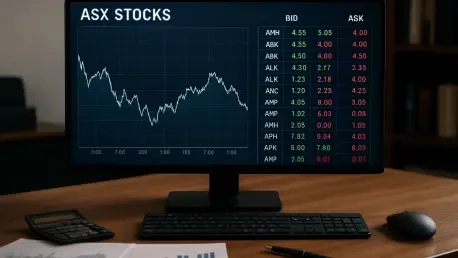In the dynamic landscape of May 2023, the Australian investment scene is grappling with significant turbulence following the Reserve Bank of Australia’s (RBA) unexpected decision to elevate the benchmark cash rate to 3.85%, marking the highest level since 2012, and sending ripples through the economy. This 25 basis point increase, announced on May 3, has heightened borrowing costs for households and businesses alike. As a result, consumer spending and investment activity face potential slowdowns, creating a challenging environment for those navigating the Australian Securities Exchange (ASX). Yet, within this uncertainty lies opportunity for astute investors. Certain sectors and companies are showing resilience and growth potential despite these economic headwinds. This article delves into five standout ASX-listed stocks across retail, energy, technology, and telecommunications, offering insights into how they might thrive amidst rising interest rates and provide a buffer against market volatility.
Navigating the Economic Storm
The RBA’s surprise rate hike in early May 2023 has caught many off guard, following a brief pause in April that had hinted at possible stabilization. This tightening of monetary policy is poised to squeeze disposable incomes, particularly for those with variable-rate mortgages taken during the low-rate environment of recent years. Businesses, too, face higher costs of capital, which could dampen expansion plans and profitability in cyclical industries. For investors on the ASX, this shift necessitates a strategic pivot toward sectors less sensitive to domestic economic fluctuations. The focus is shifting toward companies that cater to essential needs or benefit from global demand trends, as these are more likely to maintain stability or even grow under pressure. Understanding this economic backdrop is crucial for identifying stocks that can serve as safe havens or growth opportunities in a tightening market.
Beyond the immediate impact of higher borrowing costs, the broader implications of the RBA’s policy underscore a cautious outlook for Australia’s economy in 2023. Reduced consumer spending power could lead to weaker retail sales in discretionary categories, while industries reliant on debt financing may struggle to sustain growth. However, this environment also sharpens the appeal of defensive investments—those tied to everyday necessities or critical resources. Investors are increasingly looking at historical performance and forward-looking indicators like earnings forecasts to gauge resilience. The current climate, while challenging, offers a chance to reassess portfolios with an eye toward balancing risk and reward. This means prioritizing companies with strong fundamentals and diversified revenue streams that can weather domestic downturns while tapping into stable or growing external markets.
Sector Strengths in a High-Rate Environment
Amid the economic pressures of May 2023, certain sectors stand out for their ability to endure or even prosper. Retail operations focused on consumer staples are proving their mettle, as demand for groceries and household essentials remains largely unaffected by tighter budgets. The resources sector, particularly energy, is another bright spot, driven by global supply constraints and geopolitical factors such as the ongoing conflict in Ukraine, which continue to bolster demand for oil and gas. Telecommunications, integral to daily connectivity, offers a stable foundation, while innovative technology platforms catering to niche needs are carving out growth paths. This mix of defensive and opportunistic sectors provides a framework for investors to navigate the current landscape with confidence, balancing immediate stability with long-term potential.
Another key consideration is how these sectors align with broader market trends and consumer behavior in a high-rate environment. Retail giants with strong brand loyalty and diversified offerings can maintain customer bases even as discretionary spending wanes. Energy companies benefit from external buffers, where international demand dynamics often outweigh local economic challenges. Meanwhile, telecommunications firms are insulated by the essential nature of their services—internet and mobile connectivity are non-negotiable for most. Technology platforms that address cost-saving or income-generating needs also gain traction during downturns, as individuals and businesses seek efficiency. Together, these sectors highlight a strategic approach for ASX investors: focus on resilience through essential demand and capitalize on growth where innovation meets necessity.
Retail Titans Leading the Charge
In the retail sector, two ASX giants emerge as compelling picks for May 2023 due to their focus on consumer staples. Wesfarmers (ASX: WES), with its sprawling portfolio including household names like Bunnings, Kmart, and Officeworks, stands as a defensive stronghold. Its share price has climbed over 12% year-to-date, reflecting investor confidence in its ability to deliver consistent returns. Earnings per share projections of $2.14 for FY23 and $2.25 for FY24 further cement its appeal, with a forward price-to-earnings ratio hovering around 24 and 23 for those years. This diversified retail operation thrives on meeting everyday needs, making it less vulnerable to economic swings and a reliable choice for those seeking stability in turbulent times.
Similarly, Woolworths Group (ASX: WOW) showcases remarkable resilience with its extensive network of over 1,400 stores across Australia and New Zealand. Anchored by its flagship supermarket chain and Big W, the company reported a 4% sales increase to $33.17 billion in its half-year results, alongside a 14% jump in net profit after tax to $907 million. A fully-franked interim dividend of 46 cents per share, up nearly 18%, signals strong financial health. With a year-to-date share price rise exceeding 17%, Woolworths exemplifies the enduring demand for essential goods. This performance positions it as a cornerstone for investors looking to mitigate risks associated with rising interest rates, offering both steady returns and a buffer against broader market volatility.
Energy Sector’s Global Advantage
Turning to the resources sector, Beach Energy (ASX: BPT) captures attention as a standout performer for May 2023. Based in Adelaide, this oil and natural gas company operates across multiple basins in Australia and New Zealand, benefiting from robust global demand. Its FY22 results revealed a 15% revenue increase to $1.749 billion and a 16.5% rise in underlying EBITDA to $1.111 billion, highlighting operational strength. The ongoing geopolitical tensions, particularly the Ukraine conflict, have tightened global energy supplies, creating a favorable environment for companies like Beach Energy. This external demand acts as a critical buffer against domestic economic challenges, making it an attractive option for ASX investors seeking exposure to international market dynamics.
The broader appeal of energy stocks in the current climate lies in their ability to capitalize on structural supply issues that transcend local rate hikes. Beach Energy’s strategic positioning allows it to tap into sustained demand from major markets like China, which continues to prioritize infrastructure investment despite its own economic hurdles. This global focus insulates the company from much of the RBA’s monetary tightening impact, offering a hedge for portfolios otherwise exposed to domestic slowdowns. Furthermore, the firm’s consistent financial growth underscores its capacity to deliver value even as energy prices fluctuate. For those on the ASX looking to diversify beyond traditional defensive plays, this resources player presents a compelling case for balancing risk with opportunity in a high-rate environment.
Tech and Telecom as Pillars of Growth and Stability
On the innovation front, Airtasker (ASX: ART) emerges as a unique growth story within the technology space for May 2023. As Australia’s leading online marketplace for local services, it addresses a vast $600 billion market across multiple countries, including the US and UK. Its platform, which connects users for tasks like cleaning or handyman work, saw a gross marketplace volume of $189.6 million in FY22, up nearly 24% from the prior year. Economic downturns often amplify the relevance of such services, as individuals seek affordable solutions or additional income streams. This adaptability makes Airtasker a stock with significant upside potential, appealing to investors who value innovation and resilience amid RBA-driven challenges.
In contrast, Telstra (ASX: TLS) offers a bedrock of stability as Australia’s largest telecommunications provider. With services deemed essential for modern connectivity, its demand remains inelastic regardless of economic conditions. A year-to-date share price increase of over 8.7% and a target price of $4.70 set by analysts (against a current $4.30) reflect strong market optimism. Telstra’s deep-rooted presence in internet and mobile services ensures consistent revenue, positioning it as a blue-chip stock for risk-averse investors. This telecom giant complements growth-oriented picks by providing a steady foundation, allowing for a balanced approach on the ASX. Together, Airtasker and Telstra highlight how technology and telecommunications can cater to both emerging needs and enduring necessities in a high-rate landscape.
Building a Resilient Portfolio
Reflecting on the economic challenges of May 2023, the selection of Wesfarmers, Woolworths, Beach Energy, Airtasker, and Telstra offered a strategic blend of stability and opportunity for ASX investors. These stocks spanned critical sectors that demonstrated resilience against the backdrop of the RBA’s rate hikes. Retail leaders provided a defensive shield through consistent consumer demand, while energy benefited from global tailwinds. Technology and telecommunications rounded out the mix, balancing innovation with essential services. For those who navigated that period, the lesson was clear: diversification across sectors with strong fundamentals was vital to mitigating risks.
Looking back, the actionable takeaway from that time was to prioritize companies with inelastic demand or exposure to favorable international trends. Investors were encouraged to monitor earnings forecasts and sector-specific developments closely, adjusting allocations to balance immediate safety with long-term growth. As economic conditions evolved beyond May 2023, maintaining flexibility in portfolio construction remained essential, ensuring adaptability to future monetary shifts while capitalizing on the strengths of these standout ASX stocks.









